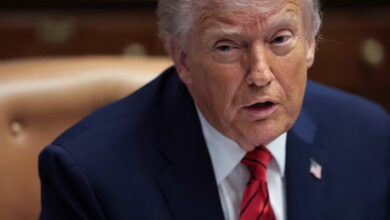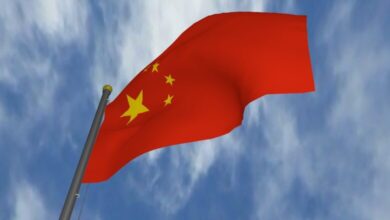
A professor of the Middle East Studies Institute at the Shanghai International Studies University, Jing Zhao, stated that on April 2, the Trump administration announced it would impose “reciprocal tariffs” on all trading partners, with a 34 percent rate applied to China.
On April 8, it further imposed an additional 50 percent tariff on Chinese goods, bringing the total reciprocal tariff rate to 84 percent. Combined with other tariffs, the overall tariff rate on Chinese goods has soared from 12 percent in 2018 to 104 percent this April.
In this exclusive interview, Zhao explained that the US has adopted a “benchmark tariff + reciprocal tariff” model imposing a 10 percent benchmark tariff on all imported goods, an additional 10 percent tariff on Chinese products under the pretext of fentanyl, and an 84 percent reciprocal tariff.
This brings the overall tariff rate on Chinese goods to 104 percent, with actual rates potentially higher depending on the industry.
When asked as to how effective has the US tariff policy been, Zhao said that the protectionist policy of imposing tariffs has failed to improve the US trade deficit. In 2024, the US trade deficit reached $1.21 trillion, an increase of 50 percent compared to 2017, before the trade war began.
The actual cost of the trade war has been borne by America’s households and businesses.
According to an analysis by Yale University, this round of tariff policies has led to a 2.3 percent increase in US inflation, a 2.8 percent rise in food prices, and an 8.4 percent increase in automobile prices, resulting in an annual loss of US$3,800 for the average American household.
In the face of America’s unilateral tariff bullying, China has responded with resilience and determination.
The Chinese government has introduced several countermeasures, including imposing an 84 percent tariff on all US imports, filing a lawsuit against the US under the WTO dispute settlement mechanism, placing multiple US entities on export control lists, and implementing export restrictions on rare earth materials.
These actions not only defend China’s legitimate interests but also uphold the fairness and freedom of the global trading system.
She added that China’s economy, characterized by its strong resilience, is confident and capable of withstanding the new round of US containment, adding that the decline in exports to the US will not have a destabilizing impact on China’s economy.
From the perspective of Sino-US trade, China’s reliance on the US market has been decreasing in recent years, with the proportion of exports to the US dropping from 19.2 percent in 2018 to 14.7 percent in 2024.
Meanwhile, the US remains highly dependent on certain Chinese products, with some categories having a dependency rate exceeding 50 percent.
As it becomes harder alternative sources in the short term, a complete disruption of Sino-US trade becomes impossible.
From the perspective of China’s economy as a whole, as the world’s second-largest economy, China’s GDP reached $18.94 trillion in 2024, with an economic growth rate of five percent, continuing to serve as a key driver of global economic growth.
China’s massive economic scale and comprehensive industrial system enable it to withstand external market fluctuations and ensure stable economic operations.
Zhao explained that US suppression has forced China to accelerate technological innovation and industrial upgrading. China’s “14th Five-Year Plan” prioritizes self-reliance and self-strengthening in science and technology as a national strategy, with continuous growth in research and development investment.
In 2024, China’s R&D expenditure accounted for 2.68 percent of its GDP, surpassing the EU average of 2.11 percent and approaching the OECD average of 2.73 percent.
China has concentrated resources on breakthroughs in key areas such as semiconductors, artificial intelligence, and aerospace.
The domestic production rate of semiconductor equipment increased from less than 10 percent in 2018 to approximately 20 percent in 2023.
China’s share of global 5G patents exceeds 38 percent, while new energy vehicle exports have risen to the top globally, and the C919 large passenger aircraft has been put into commercial use.
China is transitioning from “catch-up innovation” to “original innovation,” driving comprehensive industrial upgrades through technological innovation.
According to Zhao, China’s “Dual Circulation” strategy has shown significant results.
China is promoting mutual reinforcement between domestic and international circulations to mitigate the impact of external shocks on the economy. On the one hand, the dominant role of the domestic circulation has been strengthened, with enhanced resilience in domestic demand and industrial chains.
The government has introduced a series of policies to stimulate the domestic market, increase household incomes, and reduce burdens, using domestic demand to offset export risks.
In 2024, domestic demand contributed over 80 percent to economic growth, becoming the main driver of growth. Among enterprises with export performance, nearly 85 percent also engage in domestic sales, with domestic sales accounting for nearly 75 percent of total sales. On the other hand, international circulation has been improved in quality and efficiency, with high-level opening-up countering external blockades.
China has deepened economic and trade cooperation with countries along the “Belt and Road.” In 2024, total imports and exports with BRI countries reached $3 trillion, a year-on-year increase of 6.4 percent, with the proportion of these countries in China’s total imports and exports exceeding 50 percent for the first time.
China is diversifying its export markets and international cooperation, Zhao said, adding that it is accelerating its shift away from over-reliance on traditional markets, turning instead to emerging economies in Southeast Asia, Latin America, and the Middle East.
In 2024, exports to ASEAN and Latin America grew by 8.4 percent and 11.9 percent year-on-year, respectively, significantly higher than the 2.5 percent growth rate for exports to the US.
At the same time, China is deepening institutional opening-up through free trade agreement (FTA) networks and the Regional Comprehensive Economic Partnership (RCEP).
By 2025, China had signed 23 FTAs with 30 countries and regions, with the proportion of imports and exports to FTA partners increasing to 34 percent.
The expansion of logistics hubs such as the China-Europe Railway Express and Beibu Gulf Port has further opened up trade channels between Asia, Europe, and Africa.
America’s imposition of tariffs harms both others and itself and is unlikely to achieve its intended goals, according to Zhao.
In the face of the US’s tariff bullying, China remains calm and resolute, focusing on managing its own affairs, she added.
By strengthening technological innovation, optimizing industrial structures, and expanding international markets, China has effectively countered external pressures and maintained stable economic growth, demonstrating strategic resilience.
China welcomes dialogue with the US based on equality, mutual respect, and reciprocity.
However, if the US insists on waging tariff and trade wars, China is prepared to see it through to the end.
The Chinese professor said that looking ahead, China will continue to adhere to reforms and opening-up, promoting high-quality economic development, and strengthening international cooperation to safeguard the multilateral trading system, thereby making greater contributions to the stability and development of the global economy.




